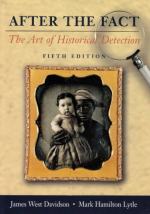|
This section contains 691 words (approx. 2 pages at 400 words per page) |

|
Chapter 4: Jackson's Frontier - and Turner's Summary and Analysis
Chapter 4 examines the role that historical theory plays in the study of history. The authors use the figure of Andrew Jackson as an example subject and begin with the "frontier theory" of Frederick Jackson Turner.
Turner was a young historian who introduced what would become an influential theory of American history in a talk given at the Columbian Exposition in Chicago in 1893. Turner's talk was called "The Significance of the Frontier in American History." In it, he outlined his theory that national traits that had come to be recognized as distinctly American such as individualism and democracy could be directly related to the frontier experience unique to American development. The frontier pitted man against nature and broke down the old class distinctions inherited from England and still present in the East...
(read more from the Chapter 4: Jackson's Frontier - and Turner's Summary)
|
This section contains 691 words (approx. 2 pages at 400 words per page) |

|




